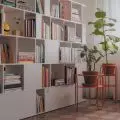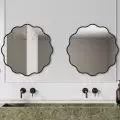The Polish-Russian design team of Aleksandra Bator, Grzegorz Konieczny (graduates of the Faculty of Architecture at the Cracow University of Technology) and Elina Timergalieva (graduate of the Kazan State University of Architecture and Engineering), currently studying architecture in Sweden and Italy, won an honorable mention in the international Brise-Vent Havre competition organized by the TerraViva platform. Their project BRISE-VENT HAVRE 2.0 "The Path Towards The Water " is a proposal to revitalize the old French port of Le Havre and create a modern musée.
axonometry of the project "Brise-Vent Havre 2.0: The Path Towards The Water".
© Aleksandra Bator, Elina Timergalieva and Grzegorz Konieczny
Brise-Vent Havre competition
The challenge of the competition was to transform a forgotten concrete structure into a modern museum that could become a cultural center in the French city of Le Havre. The monumental "gray sail" from the 1940s no longer fulfills its original purpose of protecting the harbor from gusts of wind, so the competition organizers invited designers to create a concept for a new musuem, bringing the forgotten site to life.A key element of the competition was to pay special attention to social aspects, which encouraged participants to develop hybrid programs that could attract both the local community and international tourists and visitors.
module
© Aleksandra Bator, Grzegorz Konieczny, Elina Timergalieva
awarded works
The works awarded in the competition preserved the historical heritage, while proposing innovative solutions. The jury appreciated the creative use of sustainable materials, especially wood, and the integration of green areas, which transformed the site into a flexible, multifunctional space. A common theme for all participants in the competition was preserving the site's industrial heritage while introducing forward-looking solutions that foster cultural and social interaction. First place was won by a team from Turkey (Öznur Çağlayan, Ece Uğurlu, Devrim Nasmir, Can Özdoğan, Yiğit Doğan, Gaye Karbeyaz) for the "Le Havre Port Cultural Center" project. The second prize went to representatives of China (Dingdong Tang, Zehui Li, Haisheng Xu), authors of the "DiveAscent" project, and the third prize went to the French project team "Wind Machine" (Xavier Brunet, Clémence Prévost, Anthony Fourrier, Sara Belrhaiti, Hiba Elhaddad).
permanent exhibition
© Aleksandra Bator, Grzegorz Konieczny, Elina Timergalieva
BRISE-VENT HAVRE 2.0 "The Path Towards The Water".
The goal of the Polish-Russian team's project, in which the structure of the existing building plays a key role, was not to disturb its current value, but to emphasize its importance in the context of the port in the French city of Le Havre by introducing new architecture. The proposed approach is to adapt the preserved structure to new functions and introduce a flexible program to revitalize the existing area and encourage both residents and visitors to explore the harbor area. The strong connection of the immediate area to the sea and the experience of water are key factors in defining the proposed museum exhibitions.
green zone, corridor
© Aleksandra Bator, Grzegorz Konieczny, Elina Timergalieva
The building's new function, dedicated primarily to museum spaces, is designed to immerse visitors in the water experience and deepen their understanding of the strong relationship between the city and the sea. All museum spaces are organized around a new internal pathway, leading users and visitors from the entrance through the proposed zones. Interactive elements engage visitors' senses, offering both educational and emotional moments. The path ends at a direct vantage point facing the water, which is the culmination of the journey. The purpose of this element is to highlight the main theme of the exhibition - the physical and spiritual relationship between water and humanity.
visualization
© Aleksandra Bator, Grzegorz Konieczny, Elina Timergalieva


































































